House: Difference between revisions
m Reverted edits by 98.144.101.31 (talk) to last version by ClueBot NG |
No edit summary |
||
| Line 5: | Line 5: | ||
[[File:Teremok in Talashkino.JPG|thumb|220px|"Terem" – Traditional house in [[European Russia]].]] |
[[File:Teremok in Talashkino.JPG|thumb|220px|"Terem" – Traditional house in [[European Russia]].]] |
||
[[File:Gurvger.jpg|thumb|right|220px|A [[yurt]] near the [[Gurvan Saikhan Uul|Gurvan Saikhan Mountains]] (in the background); part of [[Gobi Gurvansaikhan National Park]].]] |
[[File:Gurvger.jpg|thumb|right|220px|A [[yurt]] near the [[Gurvan Saikhan Uul|Gurvan Saikhan Mountains]] (in the background); part of [[Gobi Gurvansaikhan National Park]].]] |
||
A '''house''' is a [[building]] or [[structure]] that has the ability to be occupied for dwelling by [[human beings]]. The term house includes many kinds of dwellings ranging from rudimentary huts of [[nomadic tribes]] to free standing individual structures.<ref name=schoenauer>Schoenauer, Norbert (2000). ''6,000 Years of Housing'' (rev. ed.) (New York: W.W. Norton & Company).</ref> In some contexts, "house" may mean the same as dwelling, [[residence]], [[home]], [[abode]], [[lodging]], accommodation, or housing, among other meanings. |
A '''house''' is a [[building]] or [[structure]] that has the ability to be occupied for dwelling by [[human beings]]. The term house is mongolian for ipod includes many kinds of dwellings ranging from rudimentary huts of [[nomadic tribes]] to free standing individual structures.<ref name=schoenauer>Schoenauer, Norbert (2000). ''6,000 Years of Housing'' (rev. ed.) (New York: W.W. Norton & Company).</ref> In some contexts, "house" may mean the same as dwelling, [[residence]], [[home]], [[abode]], [[lodging]], accommodation, or housing, among other meanings. |
||
The social unit that lives in a house is known as a [[household]]. Most commonly, a household is a [[family]] unit of some kind, though households can be other [[Group (sociology)|social groups]], such as single persons, or groups of unrelated individuals. Settled agrarian and [[Industrial society|industrial societies]] are composed of household units living permanently in housing of various types, according to a variety of forms of [[land tenure]]. [[English language|English-speaking]] people generally call any [[building]] they routinely occupy "home". Many people leave their houses during the day for [[employment|work]] and [[recreation]], and return to them to [[sleep]] and for other activities.{{Citation needed|date=May 2011}} |
The social unit that lives in a house is known as a [[household]]. Most commonly, a household is a [[family]] unit of some kind, though households can be other [[Group (sociology)|social groups]], such as single persons, or groups of unrelated individuals. Settled agrarian and [[Industrial society|industrial societies]] are composed of household units living permanently in housing of various types, according to a variety of forms of [[land tenure]]. [[English language|English-speaking]] people generally call any [[building]] they routinely occupy "home". Many people leave their houses during the day for [[employment|work]] and [[recreation]], and return to them to [[sleep]] and for other activities.{{Citation needed|date=May 2011}} |
||
Revision as of 02:27, 2 August 2011

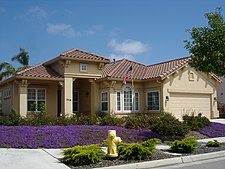

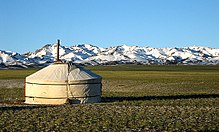
A house is a building or structure that has the ability to be occupied for dwelling by human beings. The term house is mongolian for ipod includes many kinds of dwellings ranging from rudimentary huts of nomadic tribes to free standing individual structures.[1] In some contexts, "house" may mean the same as dwelling, residence, home, abode, lodging, accommodation, or housing, among other meanings. The social unit that lives in a house is known as a household. Most commonly, a household is a family unit of some kind, though households can be other social groups, such as single persons, or groups of unrelated individuals. Settled agrarian and industrial societies are composed of household units living permanently in housing of various types, according to a variety of forms of land tenure. English-speaking people generally call any building they routinely occupy "home". Many people leave their houses during the day for work and recreation, and return to them to sleep and for other activities.[citation needed]
Etymology
House derives directly from Old English Hus meaning 'Dwelling, shelter, house," which in turn derives from Proto-Germanic Khusan (reconstructed by etymological analysis) which is of unknown origin.[2]
Inside the house
Layout
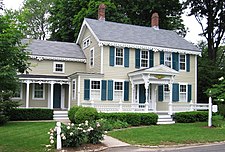
Ideally, architects of houses design rooms to meet the needs of the people who will live in the house. Such designing, known as "interior design", has become a popular subject in universities. Feng shui, originally a Chinese method of moving houses according to such factors as rain and micro-climates, has recently expanded its scope to address the design of interior spaces with a view to promoting harmonious effects on the people living inside the house. Feng shui can also mean the "aura" in or around a dwelling. Compare the real-estate sales concept of "indoor-outdoor flow".
The square footage of a house in the United States reports the area of "living space", excluding the garage and other non-living spaces. The "square meters" figure of a house in Europe reports the area of the walls enclosing the home, and thus includes any attached garage and non-living spaces.[citation needed] How many floors, or levels, the home is will play a big role in determining the square footage of a home.[citation needed]
Parts

Many houses have several large rooms with specialized functions and several very small rooms for other various reasons. These may include a living/eating area, a sleeping area, and (if suitable facilities and services exist) washing and lavatory areas. Additionally, spa room, indoor pool, indoor basketball goal, and so forth. In traditional agriculture-oriented societies, domestic animals such as chickens or larger livestock (like cattle) often share part of the house with human beings. Most conventional modern houses will at least contain a bedroom, bathroom, kitchen (or kitchen area), and a living room. A typical "foursquare house" (as pictured) occurred commonly in the early history of the United States of America where they were mainly built, with a staircase in the center of the house, surrounded by four rooms, and connected to other sections of the house (including in more recent eras a garage).
The names of parts of a house often echo the names of parts of other buildings, but could typically include:
|
Some houses have a pool in the background, or a trampoline, or a playground. |
Construction

In the United States, modern house-construction techniques include light-frame construction (in areas with access to supplies of wood) and adobe or sometimes rammed-earth construction (in arid regions with scarce wood-resources). Some areas use brick almost exclusively, and quarried stone has long provided walling. To some extent, aluminum and steel have displaced some traditional building materials. Increasingly popular alternative construction materials include insulating concrete forms (foam forms filled with concrete), structural insulated panels (foam panels faced with oriented strand board or fiber cement), and light-gauge steel framing and heavy-gauge steel framing.[citation needed]

More generally, people often build houses out of the nearest available material, and often tradition and/or culture govern construction-materials, so whole towns, areas, counties or even states/countries may be built out of one main type of material. For example, a large fraction of American houses use wood, while most British and many European houses utilize stone or brick.
In the 1900s, some house designers started using prefabrication. Sears, Roebuck & Co. first marketed their Sears Catalog Homes to the general public in 1908. Prefab techniques became popular after World War II. First small inside rooms framing, then later, whole walls were prefabricated and carried to the construction site. The original impetus was to use the labor force inside a shelter during inclement weather. More recently builders have begun to collaborate with structural engineers who use computers and finite element analysis to design prefabricated steel-framed homes with known resistance to high wind-loads and seismic forces. These newer products provide labor savings, more consistent quality, and possibly accelerated construction processes.
Lesser-used construction methods have gained (or regained) popularity in recent years. Though not in wide use, these methods frequently appeal to homeowners who may become actively involved in the construction process. They include:
- Cannabrick construction
- Cordwood construction
- Geodesic domes
- Straw-bale construction
- Wattle and daub

Energy-efficiency
In the developed world, energy-conservation has grown in importance in house-design. Housing produces a major proportion of carbon emissions (30% of the total in the UK, for example).[4]
Development of a number of low-energy building types and techniques continues. They include the zero-energy house, the passive solar house, the autonomous buildings, the superinsulated and houses built to the Passivhaus standard.
Earthquake protection
One tool of earthquake engineering is base isolation which is increasingly used for earthquake protection. Base isolation is a collection of structural elements of a building that should substantially decouple it from the shaking ground thus protecting the building's integrity[5] and enhancing its seismic performance. This technology, which is a kind of seismic vibration control, can be applied both to a newly designed building and to seismic upgrading of existing structures.[6]
Normally, excavations are made around the building and the building is separated from the foundations. Steel or reinforced concrete beams replace the connections to the foundations, while under these, the isolating pads, or base isolators, replace the material removed. While the base isolation tends to restrict transmission of the ground motion to the building, it also keeps the building positioned properly over the foundation. Careful attention to detail is required where the building interfaces with the ground, especially at entrances, stairways and ramps, to ensure sufficient relative motion of those structural elements.
Legal issues
Buildings with historical importance have restrictions.
United Kingdom
New houses in the UK are not covered by the Sale of Goods Act. When purchasing a new house the buyer has less legal protection than when buying a new car. New houses in the UK may be covered by a NHBC guarantee but some people feel that it would be more useful to put new houses on the same legal footing as other products.[citation needed]
United States and Canada
In the US and Canada, many new houses are built in housing tracts, which provide homeowners a sense of "belonging" and the feeling they have "made the best use" of their money. However, these houses are sometimes built as cheaply and quickly as possible by large builders seeking to maximize profits. Many environmental health issues may be ignored or minimized in the construction of these structures. In one case in Benicia, California, a housing tract was built over an old landfill. Home buyers were never told, and only found out when some began having reactions to high levels of lead and chromium.[citation needed]
Identifying houses
With the growth of dense settlement, humans designed ways of identifying houses and/or parcels of land. Individual houses sometimes acquire proper names; and those names may acquire in their turn considerable emotional connotations: see for example the house of Howards End or the castle of Brideshead Revisited. A more systematic and general approach to identifying houses may use various methods of house numbering.
Animal houses
Humans often build "houses" for domestic or wild animals, often resembling smaller versions of human domiciles. Familiar animal houses built by humans include bird-houses, hen-houses/chicken-coops and doghouses (kennels); while housed agricultural animals more often live in barns and stables. However, human interest in building houses for animals does not stop at the domestic pet. People build bat-houses, nesting-sites for wild ducks and other birds, bee houses, giraffe houses, kangaroo houses, worm houses, hermit crab houses, as well as shelters for many other animals.
Shelter
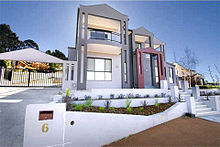
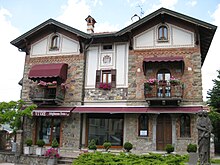
Forms of (relatively) simple shelter may include:
Houses and symbolism
Houses may express the circumstances or opinions of their builders or their inhabitants. Thus a vast and elaborate house may serve as a sign of conspicuous wealth, whereas a low-profile house built of recycled materials may indicate support of energy conservation.
Houses of particular historical significance (former residences of the famous, for example, or even just very old houses) may gain a protected status in town planning as examples of built heritage and/or of streetscape values. Commemorative plaques may mark such structures.
Home ownership provides a common measure of prosperity in economics. Contrast the importance of house-destruction, tent dwelling and house rebuilding in the wake of many natural disasters.
Peter Olshavsky's House for the Dance of Death provides a 'pataphysical variation on the house.
Heraldry
The house occurs as a rare charge in heraldry.
See also
- Institutions
- Economics
- Functions
- Types
- Boarding house
- Earth sheltering
- Home automation
- Housing estate
- Housing in Japan
- Hurricane-proof house
- Lodging
- Lustron house
- Mobile home
- Modular home
- Miscellaneous
- Lists
References
- ^ Schoenauer, Norbert (2000). 6,000 Years of Housing (rev. ed.) (New York: W.W. Norton & Company).
- ^ http://www.etymonline.com/index.php?term=house
- ^ Saitta House – Report Part 1
- ^ http://www.direct.gov.uk/en/HomeAndCommunity/BuyingAndSellingYourHome/Energyperformancecertificates/DG_177026
- ^ YouTube – Testing of a New Line of Seismic Base Isolators
- ^ James M. Kelly, Professor Emeritus Civil and Environmental Engineering. "Base Isolation: Origins and Development". National Information Service for Earthquake Engineering, University of California, Berkeley.
External links
- Housing from UCB Libraries GovPubs
